
Ischalis is a genus of moths in the family Geometridae. The genus was erected by Francis Walker in 1863. All species within this genus are endemic to New Zealand.
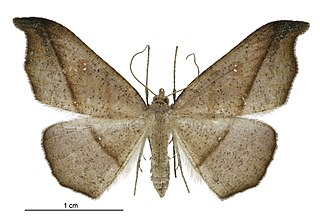
Sarisa is a monotypic moth genus in the family Geometridae and was first described by David Stephen Fletcher in 1979. The genus contains only one species, Sarisa muriferata, the hook-tip fern looper, which is endemic to New Zealand and surrounding islands. This species was described by Francis Walker in 1862. It is widespread in the North and South Islands, and has been recorded from Stewart Island, Big South Cape Island, the Chatham Islands and the Auckland Islands.

Batrachedra filicicola, also known as the ring fern spore-eater, is a species of moth of the family Batrachedridae. It is endemic to New Zealand and has been collected in the North Island. The larvae of this species feed on the spores of the silver fern. Adults are on the wing in November and December. This species is attracted to light and has also been collected in the day by sweeping silver fern fonds.
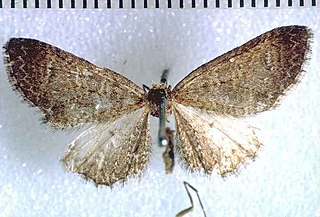
Pasiphila acompsa is a moth in the family Geometridae. It was described by Louis Beethoven Prout in 1927. It is endemic to New Zealand and has been observed in mountainous locations in both the North and South Islands. Larvae of this species have been reared on plants within the Veronica genus. Adults are on the wing from December to February.

Pasiphila bilineolata is a moth in the family Geometridae. It is endemic to New Zealand and can be found in the North and South Islands. The species inhabits native forest and shrubland and the larvae feed on Hebe species. Adults are on the wing commonly from August to January but have been observed most months of the year and are attracted to light.

Asaphodes aegrota is a species of moth in the family Geometridae. It was first described by Arthur Gardiner Butler in 1879 as Selidosema aegrota. It is endemic to New Zealand and can be found in the North, South and Stewart Islands. This species inhabits open spaces in lowland native forest. The larvae of A. aegrota feed on native herbs and have also been observed feeding of the introduced lawn daisy. The adults are variable in appearance with the markings on both sides of its wings varying in intensity. Some populations also have narrow winged females. Adults are on the wing from November until March.
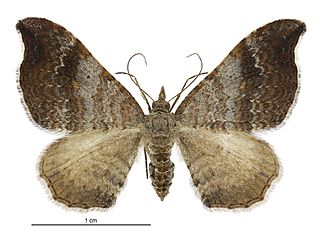
Homodotis megaspilata, also known as the small hooked-tip looper moth, is a moth of the family Geometridae. It is endemic to New Zealand and can be found throughout the country. It is regarded as being common species. The preferred habitat of this species is native forest, scrub, coastal areas and domestic gardens. Larvae feed on the dead leaves of Geniostoma ligustrifolium and likely other native plants. Once mature the larvae will pupate on the ground forming a silken cocoon protected by hiding inside two leaves of its host plant. Adults are nocturnal and are on the wing from October to April. They are attracted to light. In appearance the adults of this species are extremely variable but can be distinguished from similar species as all variations have forewings with blunt hook shaped tips.
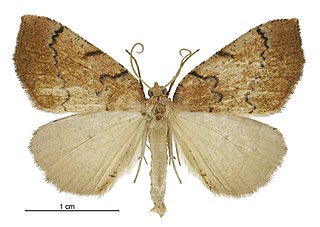
Sestra humeraria, also known as huarau looper, is a species of moth in the family Geometridae. It was described by Francis Walker in 1861. This species is endemic to New Zealand.
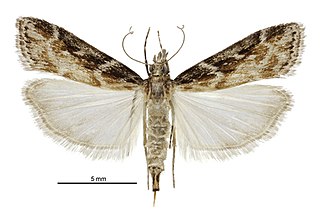
Scoparia molifera, also known as the leather-leaf Scoparia, is a species of moth of the family Crambidae. This species was first described by Edward Meyrick in 1926 and is endemic to New Zealand. It can be found in the North and South Islands. The larvae of this species make silk tunnels from which they mine the leaves of their host, the leather-leaf fern Pyrrosia eleagnifolia. Adult moths are on wing from December to February and are attracted to light.

Ctenopseustis fraterna, the brownheaded leafroller or the rusty ponga leaf-tyer, is a species of moth of the family Tortricidae. It is found in New Zealand, where it has been recorded from the North Island only. The common name is also used for the related species Ctenopseustis herana and Ctenopseustis obliquana.

Ctenopseustis filicis, also known as ginger ponga leaf-tyer, is a species of moth of the family Tortricidae. It is endemic to New Zealand and is found in the South and Stewart Islands.

Asaphodes beata is a species of moth in the family Geometridae. It is endemic to New Zealand and is a relatively common species that can be found throughout the country in native forest or scrub habitat. It can be distinguished from its close relative Asaphodes adonis by the colour of its hind wings. The larvae of this species feeds on watercress but tends to be inactive during the day. If threatened it will mimic a twig dropping to the ground. The adult moths are on the wing from October to March and are said to be attracted to white rātā. The white markings on the forewing of the adults are variable in appearance.

Asaphodes chlamydota is a moth in the family Geometridae. It is endemic to New Zealand, and can be found in the lower part of the North Island and in the South Island. It inhabits native forest and shrublands. The larvae of this species feeds on native Clematis plants including Clematis afoliata. Adults are on the wing from November to April and are regarded as having intermedia flight powers.

Asaphodes imperfecta is a moth in the family Geometridae. It is endemic to New Zealand and is found in the southern part of the South Island. The species inhabits low lying swampy native forest. The host plants of the larvae of this species is unknown. The adults are on the wing in December and January. It is classified as critically endangered by the Department of Conservation.
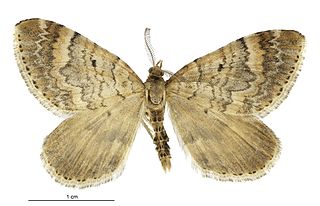
Asaphodes dionysias is a species of moth in the family Geometridae. This species is endemic to New Zealand and is only known from mountainous areas in Central Otago. It lives in open grassy mountainous habitat at altitudes up to 1750 m. It is also known to live in wetland habitat. The larvae of this species feed on native herbs. The adults of this species are on the wing in January and February. The adult female of the species has reduced wing size in comparison to the male.
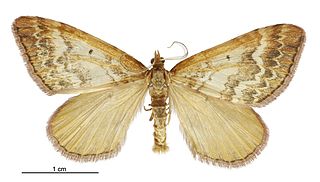
Asaphodes helias is a species of moth in the family Geometridae. It is endemic to New Zealand. It has been found in the middle and southern parts of the South Island. This species frequents tussock and scrubby habitat. The host plants of the larvae of this species include Cardamine and Ranunculus species. They have also been witnessed feeding on exotic buttercup species in the genus Bellis. Adults are on the wing in January and February.
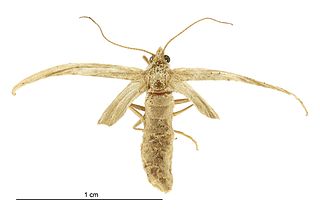
Asaphodes oraria is a species of moth in the family Geometridae. This species is endemic to New Zealand and has been observed in the southern South Island and on Stewart Island / Rakiura. The male is pale yellow coloured and the female has severely reduced wings and is flightless. The habitat of this species is tussock grasslands on coastal sand dunes and in the mountains at elevations of approximately 4,000 ft. The larvae have adapted to feeding on exotic lawn daisy species in the genus Bellis. The adults of this species are on the wing from November to April.

Ischalis nelsonaria, also known as the angled fern looper, is a species of moth of the family Geometridae. It was first described in 1875. This species is endemic to New Zealand and has been observed in both the North and South Islands. I. nelsonaria inhabits native forest. The larval host of this species is Zealandia pustulata. Larvae have also been raised on Blechnum novae-zelandiae. Adult moths of this species are variable in appearance and are nocturnal. They have been observed on the wing throughout the year but are most frequently observed in February and March. They have been observed feeding on the flowers of Metrosideros diffusa.
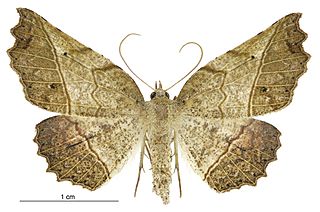
Ischalis gallaria, the striped fern looper, is a species of moth in the family Geometridae. It was first described by Francis Walker in 1860. This species is endemic to New Zealand.
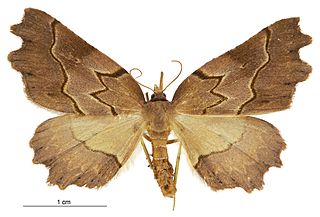
Ischalis fortinata is a species of moth in the family Geometridae. It was first described by Achille Guenée in 1868. This species is endemic to New Zealand and has been observed in both the North, South and Stewart Islands. The species inhabits native forest. The larval hosts of this species include Polystichum vestitum and Polystrichum richardii. Adults have been observed all year around but are most frequently seen from October to February.






















